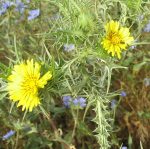 Also known as spotted oyster thistle, this annual herb is native to the Mediterranean region including southern Europe, southwest Asia, northern Africa, and the Canary Islands where it grows in fields and disturbed sites of woodlands, shrublands, and deserts. It is a member of the aster family, Asteraceae, that also includes daisy, yarrow, and lettuce. The plant grows 3’3″ tall and has a rosette of soft leaves and a stem carrying uninterrupted prickly wings with a white marginal vein. Pinnately incised, grayish-green leaves along the stem are 3.5-5.5″ long, ovate, and rigid. They have dentate margins tipped with spines and are edged with white a vein. Yellow flowerheads less than 1″ across appear singly or in clusters of 2-4 in leaf axils or at the tip of the stems in summer. Each flowerhead includes black hairs and is subtended by 5 leaf-like, oval to lanceolate bracts that are pinnately divided, spine-tipped, and have white margins. The fruit is an achene with no pappus. The genus name, Scolymus, is the Latin name for the Spanish oyster plant. The specific epithet, maculatus, is the Latin word meaning stained or spotted.
Also known as spotted oyster thistle, this annual herb is native to the Mediterranean region including southern Europe, southwest Asia, northern Africa, and the Canary Islands where it grows in fields and disturbed sites of woodlands, shrublands, and deserts. It is a member of the aster family, Asteraceae, that also includes daisy, yarrow, and lettuce. The plant grows 3’3″ tall and has a rosette of soft leaves and a stem carrying uninterrupted prickly wings with a white marginal vein. Pinnately incised, grayish-green leaves along the stem are 3.5-5.5″ long, ovate, and rigid. They have dentate margins tipped with spines and are edged with white a vein. Yellow flowerheads less than 1″ across appear singly or in clusters of 2-4 in leaf axils or at the tip of the stems in summer. Each flowerhead includes black hairs and is subtended by 5 leaf-like, oval to lanceolate bracts that are pinnately divided, spine-tipped, and have white margins. The fruit is an achene with no pappus. The genus name, Scolymus, is the Latin name for the Spanish oyster plant. The specific epithet, maculatus, is the Latin word meaning stained or spotted.
Type: Annual
Bloom: Yellow flowerheads with 5 or more leaflike, spiny bracts, in summer
Size: 3’3″ H
Light: Semi shade to full sun
Soil: Average, medium moist to dry, well-drained
Hardiness: Zones 6-9
Care: Low maintenance
Pests and Diseases: Unavailable
Propagation: Seed
Companion Plants: Golden mayweed (Matricaria aurea), wild tree tobacco ( Nicotiana glauca), golden dog’s tail (Lamarckia aurea)
Outstanding Selections: None
Photo Credit: Iorsh Wikipedia